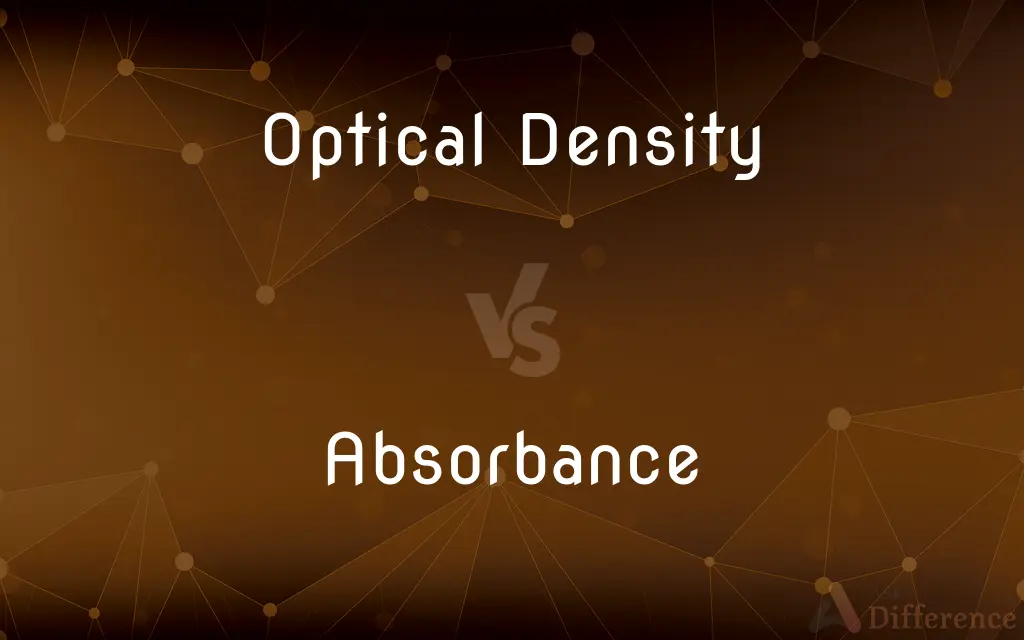Optical Density vs. Absorbance — What's the Difference?
Edited by Tayyaba Rehman — By Maham Liaqat — Published on February 26, 2024
Optical density measures the light-blocking ability of a sample, often related to its concentration, while absorbance quantifies how much light a substance absorbs at a specific wavelength, crucial in spectrophotometry.

Difference Between Optical Density and Absorbance
Table of Contents
ADVERTISEMENT
Key Differences
Optical density (OD) is a broader term that can refer to the ability of a material to obstruct the passage of light, often used in microbiology to estimate cell concentration. Absorbance (A), on the other hand, is a specific measure used in analytical chemistry to determine the concentration of a solute in solution based on the Beer-Lambert law, which relates absorbance to the properties of the material and the path length of the light through the sample.
Both concepts involve the interaction of light with a sample, whereas absorbance is specifically concerned with the fraction of light that is absorbed by the sample, not reflected or scattered. Optical density, in some contexts, might also account for scattering and reflection, making it a less specific term than absorbance.
In practice, absorbance is measured using a spectrophotometer at specific wavelengths to identify or quantify substances based on their unique absorption spectra. Optical density, particularly in microbiology, is measured using a spectrophotometer or a similar device, but the term is often used more loosely to refer to the turbidity or cloudiness of a solution, which correlates with cell biomass.
Understanding the difference between optical density and absorbance is crucial for accurately interpreting experimental results, especially in fields like analytical chemistry and microbiology, where precise measurements are essential for quantification and analysis.
Comparison Chart
Definition
General measure of how much a sample obstructs light passage.
Specific measure of the light absorbed by a sample at a particular wavelength.
ADVERTISEMENT
Usage
Common in microbiology for estimating cell concentration.
Used in analytical chemistry for determining solute concentration.
Dependency
Can depend on scattering, reflection, and absorption.
Dependent solely on the absorption of light by the sample.
Measurement
Often measured at 600 nm for microbial cultures but not limited to this.
Measured at specific wavelengths based on the absorption spectrum of the substance of interest.
Relation to Concentration
Correlates with the concentration but may require calibration for precise quantification.
Directly proportional to concentration according to the Beer-Lambert law.
Compare with Definitions
Optical Density
Can be influenced by factors other than absorption, like scattering.
In a cell suspension, optical density increases as cell concentration increases.
Absorbance
Used to determine the concentration of solutions in analytical chemistry.
Absorbance is used to calculate the concentration of an unknown sample using a calibration curve.
Optical Density
Used in various scientific fields, including biology and materials science.
Optical density measurements are crucial for assessing the quality of optical filters.
Absorbance
Essential for understanding the optical properties of materials.
Absorbance spectra can reveal the electronic structure of molecules.
Optical Density
Sometimes used interchangeably with absorbance, though they can differ.
The OD at 600 nm is a common measure for bacterial growth.
Absorbance
A specific measure of light absorption by a sample, without reflection or scattering.
Absorbance measurements at specific wavelengths can identify chemical compounds.
Optical Density
A measure of how opaque a sample is, often used to estimate microbial growth.
A high OD value indicates a dense microbial culture.
Absorbance
Fundamental in spectrophotometry for quantitative analysis.
The absorbance of a solution at 260 nm is used to quantify nucleic acids.
Optical Density
Related to but not synonymous with turbidity, which also measures light blockage.
Optical density measurements can help differentiate between clear and turbid solutions.
Absorbance
Follows the Beer-Lambert law, relating absorbance to concentration and path length.
A higher concentration of a solute results in greater absorbance.
Absorbance
(physics) A logarithmic measure of the amount of light that is absorbed when passing through a substance; the capacity of a substance to absorb light of a given wavelength; optical density.
Common Curiosities
How does the Beer-Lambert law relate to absorbance?
The Beer-Lambert law provides a linear relationship between absorbance and the concentration of an absorbing species, making absorbance a key tool for quantitative analysis.
Can absorbance be negative?
Absorbance values are typically non-negative, as they represent the logarithm of the ratio of incident to transmitted light intensity. Negative values would imply more light transmitted than incident, which is physically implausible.
Why is absorbance preferred in analytical chemistry?
Absorbance provides a specific and quantitative measure of how much light is absorbed by a substance, making it invaluable for precise concentration determinations and analysis of reaction kinetics.
Is optical density affected by the color of the solution?
Yes, the color, which indicates specific wavelengths being absorbed or transmitted, can affect the OD, especially if the measurement wavelength aligns with the color's absorption peak.
How do impurities affect optical density and absorbance measurements?
Impurities can increase the optical density and absorbance by adding more absorbing or scattering entities, potentially leading to inaccuracies if not accounted for.
Are optical density and absorbance measurements affected by the instrument used?
Yes, variations in instrument design, light sources, and detectors can lead to differences in measured values, emphasizing the need for calibration and standardization.
Can optical density be converted to absorbance?
Yes, in many contexts, especially in microbiology, the terms are used interchangeably, but technically they may not always directly correspond due to potential contributions from scattering in OD measurements.
How does concentration affect optical density and absorbance?
Both optical density and absorbance increase with concentration, as more particles or molecules in the path of light increase the likelihood of light being absorbed or scattered.
What is the significance of the wavelength in absorbance measurements?
The wavelength is crucial because different substances absorb light maximally at specific wavelengths. Choosing the right wavelength allows for selective and sensitive measurements of particular compounds.
Can turbidity be used interchangeably with optical density?
While related, turbidity and optical density are not strictly interchangeable; turbidity is a measure of the clarity of a solution and can be influenced by factors like particle size and shape, not just concentration.
What role does solvent play in absorbance measurements?
The solvent can affect absorbance by influencing the solute's optical properties and by contributing its own absorbance, particularly if measurements are made at wavelengths where the solvent also absorbs.
Can optical density be used for solid samples?
Optical density is primarily used for liquid samples; for solids, similar concepts like opacity or transmittance are more commonly used to describe light blockage.
How do you measure optical density in a lab?
Optical density is usually measured using a spectrophotometer, which passes light through a sample and measures the intensity of transmitted light at a specific wavelength.
Does the path length always affect absorbance measurements?
Yes, according to the Beer-Lambert law, absorbance is directly proportional to the path length of light through the sample, affecting the intensity of light absorbed.
How do you select the appropriate wavelength for measuring absorbance in a mixture?
The appropriate wavelength is typically one where the component of interest has a strong absorbance peak and other components have minimal absorbance, allowing for selective measurement.
Share Your Discovery

Previous Comparison
C5 Plane vs. C17 Plane
Next Comparison
Black Castor Oil vs. Castor OilAuthor Spotlight
Written by
Maham LiaqatEdited by
Tayyaba RehmanTayyaba Rehman is a distinguished writer, currently serving as a primary contributor to askdifference.com. As a researcher in semantics and etymology, Tayyaba's passion for the complexity of languages and their distinctions has found a perfect home on the platform. Tayyaba delves into the intricacies of language, distinguishing between commonly confused words and phrases, thereby providing clarity for readers worldwide.
















































